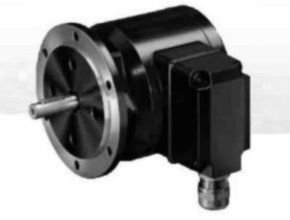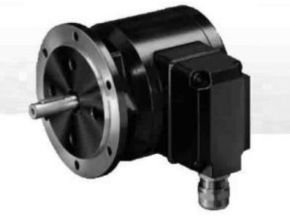Description
Baumer POG 163 is an incremental encoder designed by shaft ø11mm with EURO flange B10 and resolution 1…2500 steps/turn.

Feature
- Logic level TTL or HTL
- High resistance to shock and vibrations
- Big terminal box, pivotable through 180°
- Also in conjunction with centrifugal force switch FSL (no explosion protection)
Specification
Electrical
| Voltage supply | 5 VDC ±5 % |
| 9…26 VDC | |
| 9…30 VDC | |
| Consumption w/o load | ?100 mA |
| Resolution (steps/turn) | 1…2500 |
| Phase shift | 90° ±20° |
| Scan ratio | 40…60 % |
| Reference signal | Zero pulse, width 90° |
| Sensing method | Optical |
| Output frequency | ?120 kHz |
| Output signals | K1, K2, K0 + inverted |
| Output circuit | TTL (RS422) |
| HTL (power line driver) | |
| Interference immunity | DIN EN 61000-6-2 |
| Emitted interference | DIN EN 61000-6-4 |
| POG 10 | |
| Approval | UL approval / E256710 |
| POG 10 + FSL | |
| Output switching capacity | 6 A / 230 VAC |
| 1 A / 125 VDC | |
| Range of switching speed (ns) | 850…4900 rpm (?n = 2 rpm/s) |
Mechanical
| Housing | ø105 mm |
| Shaft | ø11 mm |
| Admitted shaft load | ?300 N axial, ?450 N radial |
| Flange | EURO flange B10 |
| Protection DIN EN 60529 | IP 66 |
| Materials | Housing: aluminium die-cast |
| Shaft: stainless steel | |
| Operating temperature | -40…+100 °C |
| -50…+100 °C (optional) | |
| Connection Terminal box | Terminal box |
| POG 10 | |
| Operating speed | ?12000 rpm (mechanical) |
| Operating torque typ. 2 Ncm | ?400 N axial, ?600 N radial |
| Rotor moment of inertia | 200 gcm² |
| Resistance | DIN EN 60068-2-6 |
| Vibration 20 g, 10-2000 Hz | |
| DIN EN 60068-2-27 | |
| Shock 200 g, 6 ms | |
| Explosion protection | II3G Ex nA T4 X (gas) |
| II3D Ex tD IP66 A22 T135°C X (dust) | |
| Weight approx. | 1,6 kg |
| POG 10 + FSL | |
| Speed (n) | ?1.25 · ns |
| Operating torque typ. | 4 Ncm |
| Rotor moment of inertia | 220 gcm² |
| Resistance | DIN EN 60068-2-6 |
| Vibration 10 g, 10-2000 Hz | |
| DIN EN 60068-2-27 | |
| Shock 100 g, 6 ms | |
| Explosion protection | II3G Ex nA T4 X (gas) |
| II3D Ex tD IP56 A22 T135°C X (dust) | |
| Weight approx. | 3.2 kg |
Download Datasheet: Baumer pog-10 & pog-10-fsl Encorder
Baumer FPDK 14PRetro Photoelectric Sensor uses light-sensitive elements to detect objects and consists of a transmitter/emitter (Light Source) and receiver (receiver).
Other Products
- Baumer Incremental Heavy Duty encoders For corrosive environment Baumer
- Baumer FPDK 14PRetro Photoelectric Sensor
- Baumer HOG 10 Heavy Duty Incremental encoders
- Baumer HOG 163 Incremental Rotary Encoder





